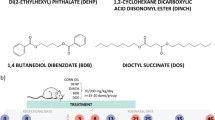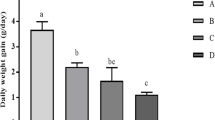Abstract
Diets of mice contained Aroclor 1254 (PCBs; 0, 1, 10 or 100 ppm). Some groups ingested PCBs beginning on gestation day (gd) 6 (vaginal plug positive day = gd 0) and continuing throughout pregnancy (acute exposure). Others were put on PCBs 90 days before mating and continued (chronic exposure) until all animals were sacrificed on gd 18. None of the PCBs diets had adverse effects on offspring. Chronic ingestion of 100 ppm reduced the conception rate. All chronic and acute 100 ppm pregnant mice had significantly altered ratios of liver to body weight. The aim of the different pretreatment regimens was to affect to variable degrees metabolism of cyclophosphamide (CPA). Bioactivation in the dam's liver is a prerequisite for embryotoxic effects in mice. Two doses of CPA were selected that caused malformations in 21.6% (10mg/kg) or 93.4% (16 mg/kg) of the fetuses when injected on gd 11. The interaction (enhancement, no effect, attenuation) between acute or chronic PCBs and CPA could thus be examined. Double stained fetal limbs and their bone lengths were evaluated. The observations were correlated with cytochrome P-450, the levels of which were elevated in all 100 ppm groups. The activities of enzymes coupled to this hemoprotein family were induced in maternal liver in an exposure mode and PCBs concentration-dependent manner. Body burdens of PCBs in dams and fetuses were related to diet levels in acutely, but not in chronically treated animals. Placental transfer of radioactivity from ring-labelled 14C-CPA, measured in control and 100 ppm chronic mice, was not significantly affected by PCBs. Contrary to what one would expect from the P-450 levels and presumably induced monooxygenase catalyzed CPA metabolism, the effects on limb development were attenuated. The amelioration observed in mice differs markedly from the effects recently reported in rats, where induction of CPA metabolism enhanced its teratogenicity.
Similar content being viewed by others
References
Alvares AP, Bickers DR, Kappas A (1973) Polychlorinted biphenyls: New type of inducer of cytochrome P448 in the liver. Proc Natl Acad Sci (Washington) 70: 1321–1325
Barrach H-J, Baumann I, Neubert D (1978) The application of in vitro systems for the evaluation of the significance of pharmacokinetic parameters for the induction of an embryotoxic effect. In: Neubert D, Merker HJ, Nau H, Langman J (eds) Role of pharmacokinetics in prenatal and perinatal toxicology, Georg Thieme Publishers Stuttgart, W. Germany pp 323–336
Claussen J, Hellmann W, Pache G (1980) The embryotoxicity of the cyclophosphamide metabolite acrolein in rabbits, tested in vivo by IV injection and by the yolk-sac method. Arzneim Forsch/Drug Res 30: 2080–2083
D'ltri FM, Kamrin MA (1983) PCBs: Human and environmental hazards. Ann Arbor Science Publishers, Ann Arbor, Michigan
Engels K (1970) Biochemical studies on the embryotoxic action of cyclophosphamide. In: Bass R, Beck F, Merker HJ, Neubert D, Randhahn B (eds) Metabolic pathways in mammalian embryos during organogenesis and its modification by drugs, Freie Universität Berlin Press, W. Germany pp 123–136
Fantel AG, Greenaway JC, Juchau MR, Shephard TH (1979) Teratogenic bioactivation of cyclophosphamide in vitro. Life Sci 25: 67–72
Fishbein L (1974) Toxicity of chlorinated biphenyls. Ann Rev Pharmacol 14: 139–156
Gibson JE, Becker BA (1968a) The teratogenicity of cyclophosphamide in mice. Cancer Res 28: 475–480
Gibson JE, Becker BA (1968b) Effect of phenobarbital and SKF 525-A on the teratogenicity of cyclophosphamide in mice. Teratology 1: 393–398
Gibson JE, Becker BA (1971) Effect of phenobarbital and SKF 525A on placental transfer of cyclophosphamide in mice. J Pharmacol Exp Ther 177: 256–262
Greenaway JC, Fantel AG, Shephard TH, Juchau MR (1982) The in vitro teratogenicity of cyclophosphamide in rat embryos. Teratology 25: 335–343
Hales BF, Jain R (1980a) Characteristics of the activation of cyclophosphamide to a mutagen by rat liver. Biochem Pharmacol 29: 256–259
Hales BF, Jain R (1980b) Effects of phenobarbital and β-naphthoflavone on the activation of cyclophosphamide to mutagenic metabolites in vitro by liver and kidney from male and female rats. Biochem Pharmacol 29: 2031–2037
Hales BF (1981a) Modification of the teratogenicity and mutagenicity of cyclophosphamide with thiol compounds. Teratology 23: 373–381
Hales BF (1981b) Modification of the mutagenicity and teratogenicity of cyclophosphamide in rats with inducers of the cytochromes P-450. Teratology 24: 1–11
Hales BF (1982) Comparison of the mutagenicity and teratogenicity of cyclophosphamide and its active metabolites 4-hydroxycyclophosphamide, phosphoramide mustard and acrolein. Cancer Res 42: 3016–3021
Juchau MR (1981) Enzymatic bioactivation and inactivation of chemical teratogens and transplacental carcinogens mutagens. In: Juchau MR (ed) The biochemical basis of chemical teratogens, Elsevier/North Holland, New York pp 63–94
Kashimoto T, Miyata H, Kunita S, Ohi G, Nakagawa J, Yamamoto SI, Tung TC, Hsu ST, Chang KJ, Tang SY (1981) Role of polychlorinated dibenzofurans in Yusho (PCB Poisoning). Arch Environ Health 36: 321–326
Kimbrough RD (1974) The toxicity of polychlorinated polycyclic compounds and related chemicals. CRC Crit Rev Toxicol 2: 445–498
Kimbrough RD, Buckley J, Fishbein L, Kasza L, Marcus W, Shibko S, Teske R (1978) Animal Toxicology. Environ Health Perspect 24: 173–184
Kitchin KT, Schmid BP, Sanyal MK (1980) Teratogenicity of cyclophosphamide in a coupled microsomal activating/embryo culture system. Biochem Pharmacol 30: 59–64
Lowry OH, Rosebrough NJ, Farr AL, Randall RJ (1951) Protein measurement with the Folin phenol reagent. J Biol Chem 193: 265–275
Masuda Y, Kagawa R, Tokudome S, Kuratsune M (1978) Transfer of polychlorinated biphenyls to the fetuses and offspring of mice. Fd Cosmet Toxicol 16: 33–37
Matthews H, Fries G, Gardner A, Garthoff L, Goldstein J, Ku Y, Moore J (1978) Metabolism and biochemical toxicity of PCBs and PBBs. Environ Health Perspect 24: 147–155
McLeod MJ (1980) Differential staining of cartilage and bone in whole mouse fetuses by alcian blue and alizarin red S. Teratology 22: 299–301
Mirkes PE, Fantel AG, Greenaway JC, Shepard TH (1980) Teratogenicity of cyclophosphamide metabolites: Phosphoramide mustard, acrolein and 4-ketocyclophosphamide in rat embryos cultured in vitro. Toxicol Appl Pharmacol 58: 322–330
Murthy VV, Becker BA, Steele WJ (1973) Effects of dosage, phenobarbital, and 2-diethylaminoethyl-2,2-diphenylvalerate on the binding of cyclophosphamide and/or its metabolites to the DNA, RNA and protein of the embryo and liver in pregnant mice. Cancer Res 33: 664–670
Nash T (1953) The colorimetric estimation of formaldehyde by means of the Hantzsch reaction. Biochem J 55: 416–421
Nau H, Neubert D (1978) Development of drug metabolizing monooxygenase systems in various mammalian species including man. Its significance for transplacental toxicity. In: Neubert D, Merker HJ, Nau H, Langman J (eds) Role of pharmacokinetics in prenatal and perinatal toxicology, Georg Thieme Publishers Stuttgart, W. Germany pp 13–44
Nau H, Spielmann H, Lo Turco Mortier CM, Winckler K, Riedel L, Obe G (1982) Mutagenic, teratogenic and pharmacokinetic properties of cyclophosphamide and some of its deuterated derivatives. Mutat Res 95: 105–118
Neubert D, Bluth U (1981) Limb bud organ cultures from mouse embryos after apparent induction of monooxygenases in utero: Effects of cyclophosphamide, dimethylnitrosamine and some thalidomide derivatives. In: Neubert D, Merker MJ (eds) Culture techniques, Walter de Gruyter, Berlin pp 175–195
Omura T, Sato R (1964) The carbon monoxide-binding pigment of liver microsomes I. Evidence for its hemoprotein nature. J Biol Chem 239: 2370–2378
Pohl RJ, Fouts JR (1980) A rapid method for assaying the metabolism of 7-ethoxyresorufin by microsomal subcellular fractions. Anal Biochem 107: 150–155
Report 1976 Final Report of the Subcommittee on the Health Effects of Polychlorinated Biphenyls and Polybrominated Biphenyls. Department of Health, Education and Welfare, Washington, DC
Schardein JL (1976) Drugs as Teratogens. CRC Press, Cleveland. pp 169–192
Schmid BP, Goulding E, Kitchin K, Sanyal MK (1981) Assessment of the teratogenic potential of acrolein and cyclophosphamide in a rat embryo culture system. Toxicology 22: 235–243
Sokal RR, Rohlf FJ (1969) Biometry. W. H. Freeman and Comp., San Francisco
Storm JE, Hart JL, Smith RF (1981) Behavior of mice after pre- and postnatal exposure to Aroclor 1254. Neurobehav Toxicol Teratol 3: 5–9
Tilson MA, Davis JA, McLachlan JA, Lucier GW (1979) The effects of polychlorinated biphenyls given prenatally on the neurobehavioral development of mice. Environ Res 18: 466–474
Ujhazy E, Preinerova M, Jozefik M (1979) Effects of cyclophos-phamide on the prenatal development of the Swiss strain mice. Neoplasm 26: 529–537
Van Cantfort J, De Graeve J, Gielen JE (1977) Radioactive assay for aryl hydrocarbon hydroxylase. Improved method and biological importance. Biochem Biophys Res Commun 79: 505–512
Watanabe M, Sugahara T (1981) Experimental formation of cleft palate in mice with polychlorinated biphenyl (PCB). Toxicology 19: 49–53
Wilson JG (1964) Teratogenic interaction of chemical agents in the rat. J Pharmacol Exp Ther 144: 429–437
Wilson JG (1965) Methods for administering agents and detecting malformations in experimental animals. In Wilson JG, Warkany J (eds) Teratology: Principles and techniques, Univ of Chicago Press, Chicago, Illinois, pp 262–277
Wilson JG (1973) Environment and Birth Defects. Academic Press, New York
Wilson JG (1977) Embryotoxicity of drugs in man. In: Wilson JG, Fraser FC (eds) Handbook of teratology, Plenum Press, New York Vol. 1 pp 309–355
Author information
Authors and Affiliations
Additional information
Dedicated to Professor Dr. med. Helmut Kewitz on the ocassion of his 65th birthday
Supported by U.S. Public Health Service grant NIH-ES02461. Presented in part at the 66th annual meeting of the Federation of American Societies for Experimental Biology in April 1982 in New Orleans, Louisiana, at the 22nd annual meeting of the Teratology Society in June 1982 in French Lick, Indiana, and at the International Symposium on PCBs in the Great Lakes in March 1982 at Michigan State University in East Lansing, Michigan.
Rights and permissions
About this article
Cite this article
Welsch, F. Effects of acute or chronic polychlorinated biphenyl ingestion on maternal metabolic homeostasis and on the manifestations of embryotoxicity caused by cyclophosphamide in mice. Arch Toxicol 57, 104–113 (1985). https://doi.org/10.1007/BF00343119
Received:
Accepted:
Issue Date:
DOI: https://doi.org/10.1007/BF00343119




